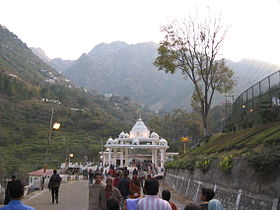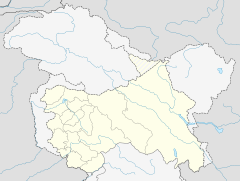- Vaishno Devi
-
Shri Mata Vaishno Devi 
Temple doorCoordinates: 34°01′47″N 75°56′54″E / 34.0296°N 75.9483°ECoordinates: 34°01′47″N 75°56′54″E / 34.0296°N 75.9483°E Name Proper name: Vishnu: Dev grah: Devanagari: श्री माता वैष्णो देवी Sanskrit transliteration: श्री माता वैष्णो देवी Tamil: ஸ்ரீ மாதா வைஷ்ணோ தேவி Marathi: श्री मत वैष्णो देवी Bengali: শঃরী মাতা বৈশঃণোদেবি Location Country: India State: Jammu and Kashmir Location: Vaishno Devi Architecture and culture Primary deity: Vaishno Devi (Shakti) Architectural styles: Hinduism History Creator: Shri Mata Vaishno Devi Shrine Board PracticesVaishno Devi Mandir (Hindi: वैष्णोदेवी मन्दिर) is one of the holy Hindu temples dedicated to Shakti, located in the hills of Vaishno Devi, Jammu and Kashmir, India. In Hinduism, Vaishno Devi, also known as Mata Rani and Vaishnavi, is a manifestation of the Mother Goddess.
The temple is near the town of Katra, in the Reasi district in the state of Jammu and Kashmir. It is one of the most revered places of worship in India. The shrine is at an altitude of 5200 feet and a distance of approximately 14 kilometres (8.7 mi) from Katra.[1] Approximately 8 million pilgrims (yatris) visit the temple every year[2] and it is the second most visited religious shrine in India, after Tirumala Venkateswara Temple. The Shri Mata Vaishno Devi Shrine Board maintains the shrine. A rail link from Udhampur to Katra is being built to facilitate pilgrimage. The nearest airport is Jammu Airport which has very high flight frequency. All leading domestic airlines have their services to Jammu Airport.
Contents
Significance
According to a Hindu epic,[which?] Maa Vaishno Devi was born in the south of India in the home of Ratnakar Sagar. Her worldly parents had remained childless for a long time. Ratnakar had promised, the night before the birth of the Divine child, that he would not interfere with whatever his child desired. Ma Vaishno Devi was called Trikuta as a child. Later She was called Vaishnavi because of Her taking birth from Lord Vishnu's lineage. When Trikuta was 9 years old, She sought her father's permission for doing penance on the seashore. Trikuta prayed to Lord Vishnu in the form of Rama. During Shree Rama's search for Sita, He reached the seashore along with His army. His eyes fell on this Divine Girl in deep meditation. Trikuta told Shree Rama that She had accepted Him as Her husband. Shree Rama told Her that during this Incarnation He had vowed to be faithful to only Sita. However pleased with her devotion , Lord Rama gave her name vaishnavi (devotee of lord rama (Maha Vishnu)and assured Her that in Kaliyuga He would manifest as Kalki and would marry Her.
In the meantime Shree Rama asked Trikuta to meditate in the cave found in the Trikuta Range of Manik Mountains, situated in Northern India.Lord Ram gave her a bow and arrows, army of monkeys and a lion for her protection, Ma decided to observe the 'Navratra' for the Victory of Shree Rama against Ravana. Hence one reads the Ramayana during the 9 days of Navratra, in remembrance of the above connection. Shree Rama promised that the whole world would sing Ma Vaishno Devi's praise. Lord Rama also said Trikuta was to become famous as Vaishno Devi and would become immortal forever.The abode of Maa Vaishno devi is attaining huge pilgrimage attraction due to Lord Rama's blessings to the goddess.[3]
With the passage of time many more stories about the Mother Goddess emerged. One such story is about Shree-Dhar.
Shree-Dhar was an ardent devotee of Ma Vaishno Devi. He resided in a village called Hansali, 2 km away from the present Katra town. Once Ma appeared to him in the form of a young bewitching girl. The young girl asked the humble Pandit to hold a 'Bhandara'. (A feast to feed the mendicants and devotees) The Pandit set out to invite people from the village and near-by places. He also invited 'Bhairav Nath' a selfish tantrik. Bhairav Nath asked Shri-Dhar how he was planning to fulfil the requirements. He reminded him of the bad consequences in case of failure. As Panditji was lost in worry, the Divine girl appeared and told Him not to be despondent as everything had been arranged. She asked that over 360 devotees be seated in the small hut. True to Her word the Bhandara went smoothly with food and place to spare. Bhairav Nath admitted that the girl had supernatural powers and decided to test Her further. He followed the Divine girl to Trikuta Hills. For 9 months Bhairav Nath was searching for the mystic girl in the mountains, whom he believed was an incarnation of the Mother Goddess. While running away from Bhairav, Devi shot an arrow into the Earth from which water gushed out. The resultant river is known as Baanganga. It is believed that by taking a bath in Baanganga (Baan: Arrow), a believer of the Mother Goddess can wash away all his sins. The banks of the river, known as Charan Paduka, are marked by Devi's foot imprints, which remains intact till date. Vaishno Devi then took shelter in a cave known as Garbh Joon near Adhkawari where she meditated for 9 months attaining spiritual wisdom and powers. Her meditation was cut short when Bhairav located her. Vaishno Devi was then compelled to take the form of Maha Kali when Bhairav tried to kill her. The manifestation of the Mother Goddess took place at the mouth of the Holy cave at Darbar. The Goddess then beheaded Bhairav with such sheer force, that his skull fell at a place known as Bhairav Ghati, 2.5 km from the Holy Cave.
In his dying moments, Bhairav pleaded for forgiveness. The Goddess knew that Bhairav's main intention in attacking her was to achieve salvation. She not only granted Bhairav liberation from the cycle of reincarnation, but also granted him a boon, whereby every devotee, in order to ensure completion of the pilgrimage, had to visit Bhairav Nath's temple near the Holy cave after the darshan of the Goddess.Meanwhile Vaishno Devi assumed the shape of a rock with three pindis (heads) and immersed herself into meditation forever.
Meanwhile, Pandit Shree-Dhar became impatient. He started to march towards Trikuta Mountain on the same path that he had witnessed in a dream. He ultimately reached the cave mouth. He made a daily routine of worshipping the 'Pindis' in several ways. His worship pleased the Goddess. She appeared in front of him and blessed him. Since that day, Shree-Dhar and his descendants have been worshipping the Goddess Mother Vaishno Devi.[4]
Picture gallery
See Also
- Shri Mata Vaishno Devi University
- Hinduism
- Patan Devi
References
- ^ http://maavaishnodevi.org
- ^ "Yatra Information". Maavaishnodevi.org. 2010-08-01. http://www.maavaishnodevi.org/help_desk_ystats.asp. Retrieved 2010-08-08.
- ^ Maata Vaihno Devi Ji
- ^ Pandit Sridhar
External links
- MataVaishnodevi.com: The complete information Website on Shri Mata Vaishnodevi
- Legends of Mata Vaishno Devi
- Shri Mata Vaishno Devi Shrine Board
- Shri Mata Vaishno Devi university
- Vaishno Devi Resources
- Vaishno Devi Shrine and Yatra
- The detailed website on Meri Maiya Vaishnodevi
- Information About Vaishno Devi Shrine and Yatra
- Story of Vaishno Devi Maa
- Story of Mata Vaishno Devi Hindi Version
- Maa Vaishnodevi Helicopter Service
- Article on Vaishno Devi from UNL
Major Hindu Temples in Jammu and Kashmir Amarnath Temple • Hari Parbat • Kalika Temple • Kheer Bhawani • Khrew • Raghunath Temple • Shankaracharya Temple • Shankaragaurishvara Temple • Shivkhori • Vaishno Devi
Categories:- Hindu goddesses
- Virgin goddesses
- Hindu temples in Jammu and Kashmir
- Hindu pilgrimage sites
- Shakti temples
- Hindu cave temples
Wikimedia Foundation. 2010.













